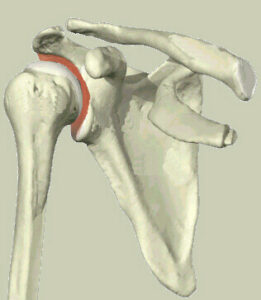Clearing up the Rotator Cuff Controversy
The college coach of one of our current pro baseball players was asking me about the rotator cuff program he’s doing with us now, and I figured I’d turn it into today’s topic. We take a bit of a different approach with it than you’ll see with a lot of guys in the industry, and it’s basically dictated by three assertions/assumptions:
1. The true function of the rotator cuff is to stabilize the humeral head on the glenoid (shoulder socket). While external rotation is important for deceleration of the crazy internal rotation velocity seen with throwing, it’s stabilization that we’re really after. As you can see, the humeral head is too large to allow for great surface area contact with the glenoid.

My feeling is that the bigger muscles – particularly scapular stabilizers, the core, and the lower half – will decelerate the crazy velocities we see as long as mechanics are effective and the deceleration arc is long enough.
2. The shoulder internally rotates at over 7,000°/s during acceleration; that’s the fastest motion in all of sports. There’s no way that the rotator cuff muscles alone with their small cross-sectional area can decelerate it. And, to take it a step further, there isn’t much that some rubber tubing is going to do to help the cause (aside from just promoting blood flow – although I’d rather get that in a more global sense with full-body flexibility circuits, as I discussed HERE).
More important than blood flow is getting range of motion (ROM) back (particularly elbow extension and shoulder internal rotation) after a pitching outing. In my experience, losses in ROM get guys injured faster than weakness, in my experience. I’ve seen quite a few people come to me who have healthy shoulders, but test poorly on classic rotator cuff strength measures. Why? Perhaps they are very strong in their scapular stabilizers, core, and lower half and have become efficient enough to handle more of the deceleration demands in areas other than the rotator cuff. Or, they may just be lucky; rotator cuff strength is still important!
3. We’ve mocked on the conventional bodybuilding community for training muscles and not movements: chest day, quads day – you get the picture. Meanwhile, the baseball community is devoting five days a week to training muscles with cross-sectional areas smaller than any of these!
I’ve had multiple discussions with Mike Reinold that reaffirm this indirectly; he emphasizes that one should never train the rotator cuff to failure, as that’s not how it works in the real world. Our job is to enhance not just its strength, but also its proprioception and rate of force development. If we chronically abuse it with training on top of the crazy demands of throwing, we never really know how strong the rotator cuff actually is. It makes you wonder how many guys in the baseball world actually have exhausted and chronically overtrained rotator cuff muscles as opposed to weak rotator cuff muscles!
With these three assertions in mind, most of our guys in the off-season will have four days of rotator cuff work spread out over two “types” of training. Days 1 and 3 (say, Monday and Thursday) would be more rhythmic stabilization drills similar to this (although the options are really only limited by your imagination):
The other two days are more classic rotator cuff work that prioritizes external rotation and horizontal abduction (we never do empty cans). I do a lot of work with cables here, plus a lot in the side-lying position (EMG activity for the cuff is highest here).
We’ll also do a lot of manual resistance external rotation stuff, as it kind of “blends” conventional cuff work with rhythmic stabilizations due to the unstable load. Here’s one option:
Later in the off-season, we’ll throw in some one-arm medicine ball deceleration catches and external rotation tosses to the wall to get the thoracic spine and hips ready for the full-body demands of throwing.
Keep in mind that – as I noted – rotator cuff exercises are just one piece of the puzzle. These are one component of a larger overall plan that addresses not only scapular stability, but also total body strength and mobility, soft tissue quality, medicine ball work, movement training, and the actual throwing program.
For more information (actually a LOT more information), check out the DVD set, Optimal Shoulder Performance: From Rehabilitation to High Performance from Mike Reinold and I.
Sign-up Today for our FREE Newsletter and receive a deadlift technique tutorial.




